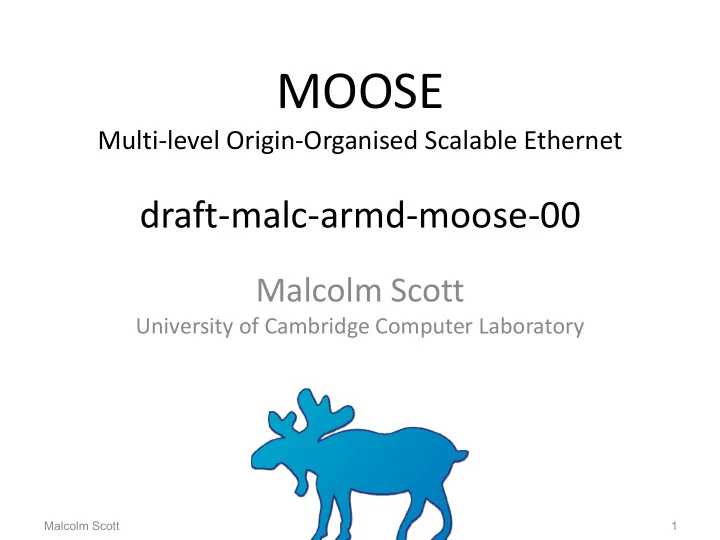

MOOSE Multi ‐ level Origin ‐ Organised Scalable Ethernet draft ‐ malc ‐ armd ‐ moose ‐ 00 Malcolm Scott University of Cambridge Computer Laboratory Malcolm Scott draft-malc-armd-moose-00 1
Aim: Hierarchical MAC address space • Current Ethernet: manufacturer ‐ assigned MAC address valid anywhere on any network – But every switch must store the location of every host • Hierarchical MAC addresses: address depends on location e.g. [switch ID].[port ID].[host ID] – Route frames according to hierarchy – Small forwarding databases – Run a routing protocol between switches • One “subnet” per switch – e.g. “02:11:11:00:00:00/24” • Don’t advertise individual MAC addresses (cf. TRILL Rbridges) • LAAs? High administrative overhead. So, instead...: Malcolm Scott draft-malc-armd-moose-00 2
MOOSE • “NAT for Ethernet” – Dynamically allocate hosts hierarchical addresses – Perform source MAC address rewriting on ingress – No encapsulation: no costly rewriting of dest address – Looks like Ethernet from outside: transparent to hosts – We have an OpenFlow implementation Malcolm Scott draft-malc-armd-moose-00 3
Beyond simple protocols • Some protocols must be rewritten by switches – Anything which puts MAC address in payload – ARP, DHCP: trivial for switches to deal with • Broadcast: unfortunate legacy – Propagate broadcast traffic using reverse path forwarding (PIM): no explicit spanning tree protocol • Multicast and anycast for free – (if we use a suitable routing protocol) – May be able to convert broadcast into multicast by inferring groups (e.g. DHCP servers) – see SEATTLE Malcolm Scott draft-malc-armd-moose-00 4
This is ongoing research; comments very welcome This was a very brief overview: much more detail in draft ‐ malc ‐ armd ‐ moose ‐ 00 Malcolm Scott Malcolm.Scott@cl.cam.ac.uk http://www.cl.cam.ac.uk/~mas90/MOOSE/ Malcolm Scott draft-malc-armd-moose-00 5
• Spare slides follow Malcolm Scott draft-malc-armd-moose-00 6
Mobility • If a host moves, it is Host B gratuitous AR P allocated a new MAC � se nt by new address by its new switch home swi tch � • Other hosts may have the old address in ARP caches 1. Forward frames , � IP Mobility style data forwarded (new switch discovers by ca re-of switch host’s old location by querying other switches for its real � MAC address) 2. Gratuitous ARP , h o s t r e l o c a t e d t o n e w s w t i c h Host Xen VM migration style A Malcolm Scott draft-malc-armd-moose-00 7
Allocation of host identifiers • Only the switch which allocates a host ID ever uses it for forwarding – More distant switches just use the switch ID • Therefore the detail of how host IDs are allocated can vary between switches – Sequential assignment – Port number and sequential portion (reduces address exhaustion attacks) – Hash of manufacturer ‐ assigned MAC address (deterministic: recoverable after crash) Malcolm Scott draft-malc-armd-moose-00 8
Security and isolation benefits • The number of switch IDs is more predictable by the network admin than the number of MAC addresses – Address flooding attacks are ineffective • Host ‐ specified MAC address is not used for switching – Spoofing is ineffective Malcolm Scott draft-malc-armd-moose-00 9
Recommend
More recommend